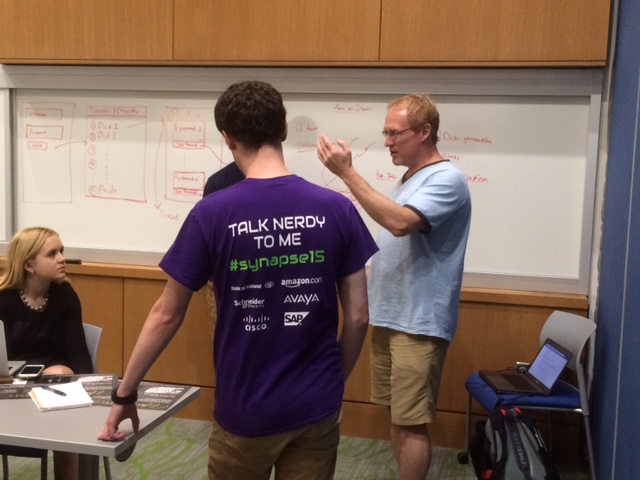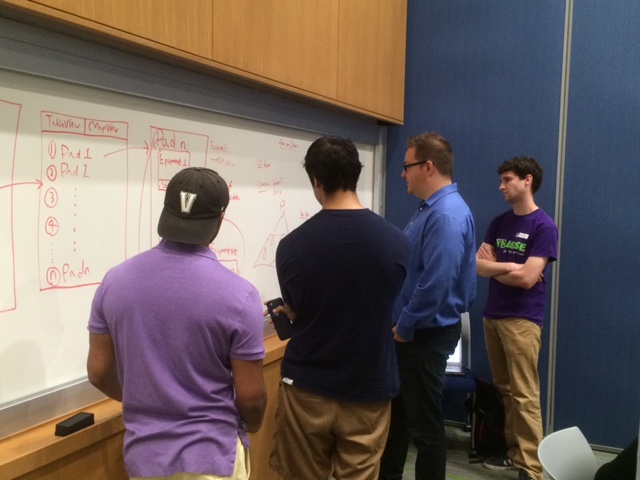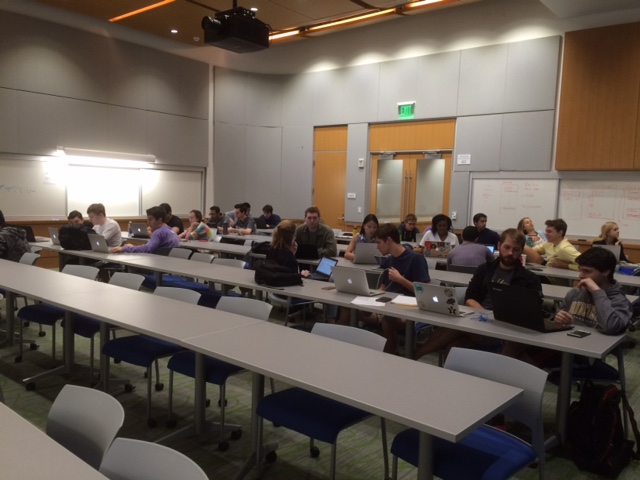Home » Mobile Cloud Computing » One-on-one with the faculty behind Tackling Big Questions with Mobile Cloud Computing (Part 1 of 3)
One-on-one with the faculty behind Tackling Big Questions with Mobile Cloud Computing (Part 1 of 3)
Posted by anderc8 on Thursday, January 19, 2017 in Mobile Cloud Computing, News.

Vanderbilt professor Doug Schmidt (right) working with students at the whiteboard during the Fall 2016 semester.
Vanderbilt University Computer Science professors Douglas C. Schmidt and Jules White recently sat down to answer a few questions about their University Course, Tackling Big Questions with Mobile Cloud Computing, which they co-taught during the Fall 2016 semester and are co-teaching again this spring. In the first installment of a three-part series, Profs. Schmidt and White discuss what motivated them to pursue and teach a University Course. They also explain the inter-disciplinary nature of their course and reflect back on the challenges and surprises they encountered during the Fall 2016 semester.
How did you first come up with the idea for this University Course?
Jules: An increasing number of faculty/staff that the Engineering school collaborates with from other parts of campus, as well as from the Vanderbilt University Medical Center (VUMC), need help building mobile apps and cloud services to facilitate their research. As individual faculty, we have a limited capacity to advise independent study students or grad students on these collaborative projects. By devising this University Course, however, we can leverage the large pool of talented undergrad and grad students at Vandy to engage in these multi-disciplinary projects. The University Course thus not only benefits CS and non-CS students, but also benefits researchers at Vanderbilt University and VUMC, since they all can participate in this unique experience and create an ecosystem for involving students on important research projects that they wouldn’t otherwise connect with.
Doug: Two trends we’ve observed over the past several years are that (1) non-CS faculty/staff throughout Vandy increasingly need apps to conduct and augment their research and (2) many CS students are interested in developing apps to gain real-world experience that furthers their professional careers. In the past, however, there’s been an “impedance mismatch” between non-CS faculty/staff (who often aren’t deeply immersed in software technologies and just want to solve their research problems) and CS students (who often aren’t deeply immersed in research and just want to focus on learning/applying software technologies). We designed our University Course to help overcome this disconnect by enabling the university students (i.e., non-CS students) to serve as a conduit between the faculty/staff mentors who understand the research problems and the CS students who actually know how to develop the apps. The university students are ideal for this role since they are well-suited to understanding and codifying multi-disciplinary problems, thereby allowing the CS students to focus on creating innovative the technology solutions.
How does your course fulfill the requirements of what a University Course is?
Doug: The design of our University Course flows from the multi-disciplinary nature of the faculty/staff mentors, who represent many Vanderbilt schools and VUMC. For example, about half the projects in last fall’s University Course developed apps focusing on medical problems, such obesity, diabetes, asthma, weight loss, or malnutrition. We collectively need to tackle these problems so that people live healthier, better, and more fulfilling lives, as well as better control spiraling healthcare costs. Another project team in our course developed a Legal Aid app to help economically disadvantaged members of the Nashville community access legal representation more affordably. Yet another project team developed an app to help alleviate traffic congestion in urban environments, such as those we face during our commutes in the Nashville metropolitan area. These are all important issues we face as citizens in our region and beyond. We therefore crafted our University Course by teaming the faculty/staff at Vanderbilt with our bright and energetic students so together they could tackle these tough societal-level problems more effectively.

Vanderbilt professor Jules White (second from right) works with students at the whiteboard during the Fall 2016 semester.
Jules: Another goal was to help address the historical lack of diversity within computer science. Although Vanderbilt is already ahead of the curve here, certain groups of people with certain demographic characteristics have historically been overrepresented in computer science, which has problematic societal effects for many reasons. By opening up our University Course to a broader, more diverse group of university students, we’re helping address these historical imbalances and allowing students to recognize the strengths of different people with different skill sets and mindsets. As shown in the recent movie Hidden Figures, when diverse groups of people start working together as a team in an environment where everyone’s contributing, they often former deeper bonds because they’re focusing on achieving a common goal, rather than simply perpetuating inaccurate stereotypes.
What kinds of challenges did you witness as CS students were paired up with the university students?
Jules: All the projects faced different challenges, depending on what the project was and what the needs and styles of the faculty/staff mentor were. It’s not easy for students to tackle tough problems that many of them had never seen before and create working solutions in just a couple of months. We initially thought we’d just get a handful of rough prototypes in our first offering due to the challenges of identifying the key requirements, selecting (and often learning) new software technologies to implement these requirements, bonding as a team, etc. We were therefore pleasantly surprised how many project teams were able to accomplish such a lot in such a short period of time. For example, the Legal Aid team built an app that Professor Ruhl in the Law School is excited about rolling out to the broader Nashville community. Likewise, the Malnutrition team was wildly successful with the app they built for their mentor Dr. Silver in VUMC. They’re now supporting her research study this semester, which is related to the Trans-Institutional Program (TIPs) project that Doug and I are working on with her and other faculty and staff from Vanderbilt and VUMC.
Doug: The Malnutrition team was so successful that they’re now working with Dr. Silver on productizing their app and will be entering the Preflight program at the Wond’ry to facilitate that transition. In particular, they’ll learn how to do product pitches, get venture funding, etc., which is remarkable in such a short period of time. That project worked well in part because the university student—Sirui Ma—is planning to go to med school, so he was highly motivated to make the project succeed. Likewise, the faculty mentor from VUMC—Dr. Silver—is a veritable font of great ideas on how to improve healthcare, so the team really came together and produced a great app.
Naturally, not every team was as successful, which underscores the fact that there’s no cookie-cutter recipe for success in a University Course. In particular, just because we mix smart students with diverse perspectives and backgrounds together for a semester doesn’t mean that they’ll always be able to jell in a short time. In general, the most successful teams were the ones that communicated continuously with each other and with their faculty/staff mentor. These observations suggest the need for additional prerequisites for the University Courses that provide the necessary foundations in digital literacy and team dynamics.

Students from the Fall 2016 course work in project teams.
Were there any surprises from the Fall 2016 semester?
Jules: One of the surprises from last semester is that we ended up having one project that was actually proposed by students, instead of from the faculty/staff mentors (which was our original approach). These students wanted to create an app that handled check-in and training for the Makerspace portion of the Wond’ry, which tracks privileges for and usage of the equipment in the Makerspace. We didn’t have any faculty/staff mentors in this area, so they took the initiative and found their own faculty mentor, Kevin Galloway. We weren’t expecting this, but it’s a great example of what happens when students get really passionate about their ideas!
